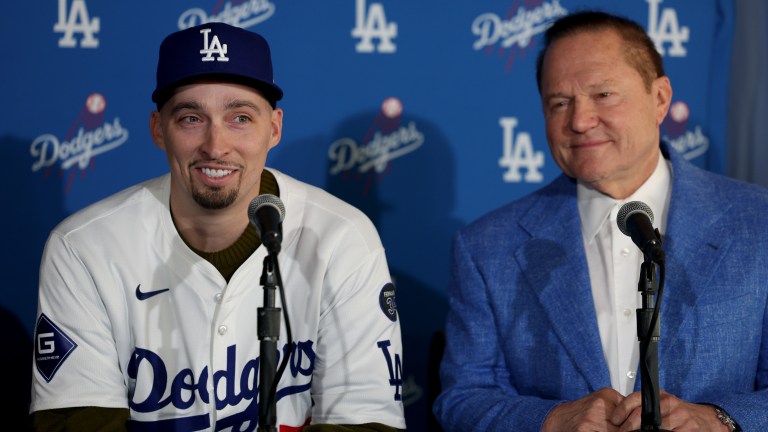Why the Dodgers Spending is Good for Baseball
Due to their wealth of talent, the Dodgers have become MLB's most polarizing team. But that doesn't mean their spending is bad for the game.

For years, the Los Angeles Dodgers shouldered criticism for being a big-market team that “bought stars but choked in October.”
Even their 2020 World Series title, achieved during a pandemic-shortened season, was derided as a “Mickey Mouse” championship. Skeptics doubted whether the Dodgers could succeed in the pressure cooker of a full postseason.
In 2024, the Dodgers flipped the narrative, capturing a World Series title in emphatic fashion.
They defeated their arch-rival San Diego Padres in the NLDS, the New York Mets in the NLCS, and the New York Yankees in the World Series (the other two biggest market squads), proving they could back up their record-setting spending and reign atop the baseball world.
Whether they succeed or falter, the Dodgers’ have mastered the art of grabbing attention with their financial boldness and star-studded roster. As the Shohei Ohtani era takes flight, the Dodgers have become baseball’s dynasty you love to hate, a storyline that benefits the sport at every level.
The Dodgers: Baseball’s New Villains
Baseball loves a villain, and the Dodgers have stepped into this role with aplomb. Historically, the New York Yankees and their distant 27 rings have held the mantle of the sport’s most hated (or celebrated) team.
But with the Yankees’ first World Series appearance since 2009 ending in a five-game loss to the Dodgers, and after missing out on Juan Soto in free agency, the National League’s biggest spender has claimed the “big bad” mantle.
At the very least, the National League now has a West Coast version of the Yankees.
The Dodgers’ dominance isn’t just about their star-studded roster; it’s about their relentless spending. In 2024, their payroll hit a staggering $353 million, resulting in a record $103 million in luxury tax penalties.
To put that in perspective, their Competitive Balance Tax (CBT) bill alone exceeds the total payroll of many small-market teams. While critics lament the financial inequality, the Dodgers’ willingness to spend bolsters the league’s narratives and rivalries. Baseball thrives on drama, and the Dodgers have become the ultimate protagonist – or antagonist, depending on your perspective.
But LA isn’t stopping there as they reload for a 2025 repeat.
Two-time Cy Young Award winner Blake Snell made headlines by signing a five-year, $182 million deal on November 30. Snell had recently pitched for the Dodgers’ two biggest rivals: the Padres (2021–23) and the Giants (2024). The day before Snell signed, Dodgers’ 2024 NLCS MVP and utility man Tommy Edman, already under team control for 2025, signed a five-year, $74 million extension.
In December, the Dodgers kept up the momentum, bringing back veteran closer Blake Treinen on a two-year, $22 million deal and signing veteran outfielder Michael Conforto to a one-year, $17 million contract.
As the calendar flipped to 2025, more moves followed. On January 3, the Dodgers re-signed fan-favorite slugger Teoscar Hernández to a three-year, $66 million deal and added KBO product and super-utility player Hyeseong Kim on a three-year, $22 million contract (not to be confused with former Padre Ha-Seong Kim).
The Dodgers may have traded homegrown second baseman Gavin Lux to the Cincinnati Reds for a minor league OF Mike Sirota and a draft pick on January 7, but let’s not forget the stable of stars LA still has under contract, in addition to their recent signings.
Heading into the 2025 season, 2018 AL MVP OF/INF Mookie Betts enters year five of a 12-year, $365M deal; SP Yoshinobu Yamamoto enters year two of a 12-year, $325M deal;
2020 NL MVP and 2024 World Series MVP 1B Freddie Freeman enters year four of a six-year, $162M deal; C Will Smith enters year two of a 10-year $140M extension;
SP Tyler Glasnow enters year two of a five-year, $136M extension, with a club option in 2028; OF/INF Chris Taylor enters the final year of a four-year, $60M deal;
INF Max Muncy enters the final year of a $24M deal, with a club option in 2026.
Additionally, lifetime Dodger, three-time Cy Young Award winner and 2014 NL MVP, SP Clayton Kershaw, is expected to return to the team in 2025.
The Dodgers’ blend of deep pockets and elite player development makes them tough to beat over a 162-game season.
With BetMGM listing them as the 2025 World Series favorite (+320 odds), they’re primed to become the first repeat champion since the Yankees in 2000.
Of course, this will come at the price of surpassing the league’s $237M luxury tax threshold for a fourth consecutive season, meaning the Dodgers’ tax rate will stay at 110%.
Shohei Ohtani and the Global Stage
At the center of the Dodgers’ recent spending spree is Shohei Ohtani, whose record-breaking 10-year, $700 million contract entering 2024 has already paid dividends, on and off the field.
Ohtani’s debut season in Dodger blue was nothing short of historic: his third MVP award (becoming the only other player besides Frank Robinson to win an AL & NL MVP), became the first ever 50-50 home run and stolen base club member, and a World Series champion.
His star power isn’t confined to the U.S.; Ohtani’s popularity has heightened the Dodgers’ standing as a global brand.
In Japan, he generated an estimated economic impact of $770 million in 2024, more than triple the Dodgers’ payroll and eclipsing the $230 million economic boost from Taylor Swift’s Eras Tour during her four-day stop in Japan.
This global appeal translates into significant viewership gains for Major League Baseball.
Globally, Ohtani’s presence helped MLB achieve an 18% increase in international viewership, with the Dodgers appearing in four of the top 10most-watched games.
The Dodgers’ World Series run continued this trend, with 15.2 million viewers tuning into Game 1 vs the Yankees on FOX, the network’s highest World Series rating since 2017. For the season, Asian audiences surged by 32%.
Ohtani’s social media clout is equally staggering. His Instagram following surged to 8.3 million by the end of 2024, dwarfing other MLB stars and fueling a 98.4 million impression day for MLB posts when he hit the 50-50 milestone.
The Dodgers’ road crowd also grew by 12.3% – 3,000 more fans than the next closest Yankees. Not to mention, the ball from his 50th home run fetched $4.4 million at auction, which is the highest ever paid for a sports ball.
Spending Fuels Competition
While critics may decry the Dodgers’ financial dominance as unfair, their spending indirectly benefits the league. Luxury tax penalties, for example, redistribute millions of dollars across the sport.
In 2024, a record $311 million in luxury tax penalties were assessed, with the Dodgers contributing nearly a third. These funds are used to support player benefits, retirement funds, and revenue-sharing programs, helping level the playing field for smaller-market teams.
Moreover, the Dodgers’ big-budget roster forces rivals to up their game. The New York Mets and Yankees have been spending big to stay competitive, creating an arms race that benefits the league’s overall talent pool. Even small-market teams benefit from the heightened interest and ticket sales generated by visits from star-studded rosters like the Dodgers’.
Why Baseball Needs a Dynasty
If you aren’t a fan, they’re the team you love to hate. Baseball thrives on narratives, and dynasties provide a compelling one. Whether you’re rooting for or against the Dodgers, their presence keeps fans engaged.
The Ohtani-led Dodgers are set to dominate headlines for years, ensuring baseball remains in the cultural conversation. Their success drives social media engagement, merchandise sales, and TV ratings – all crucial metrics for a sport vying for attention in a crowded entertainment landscape.
